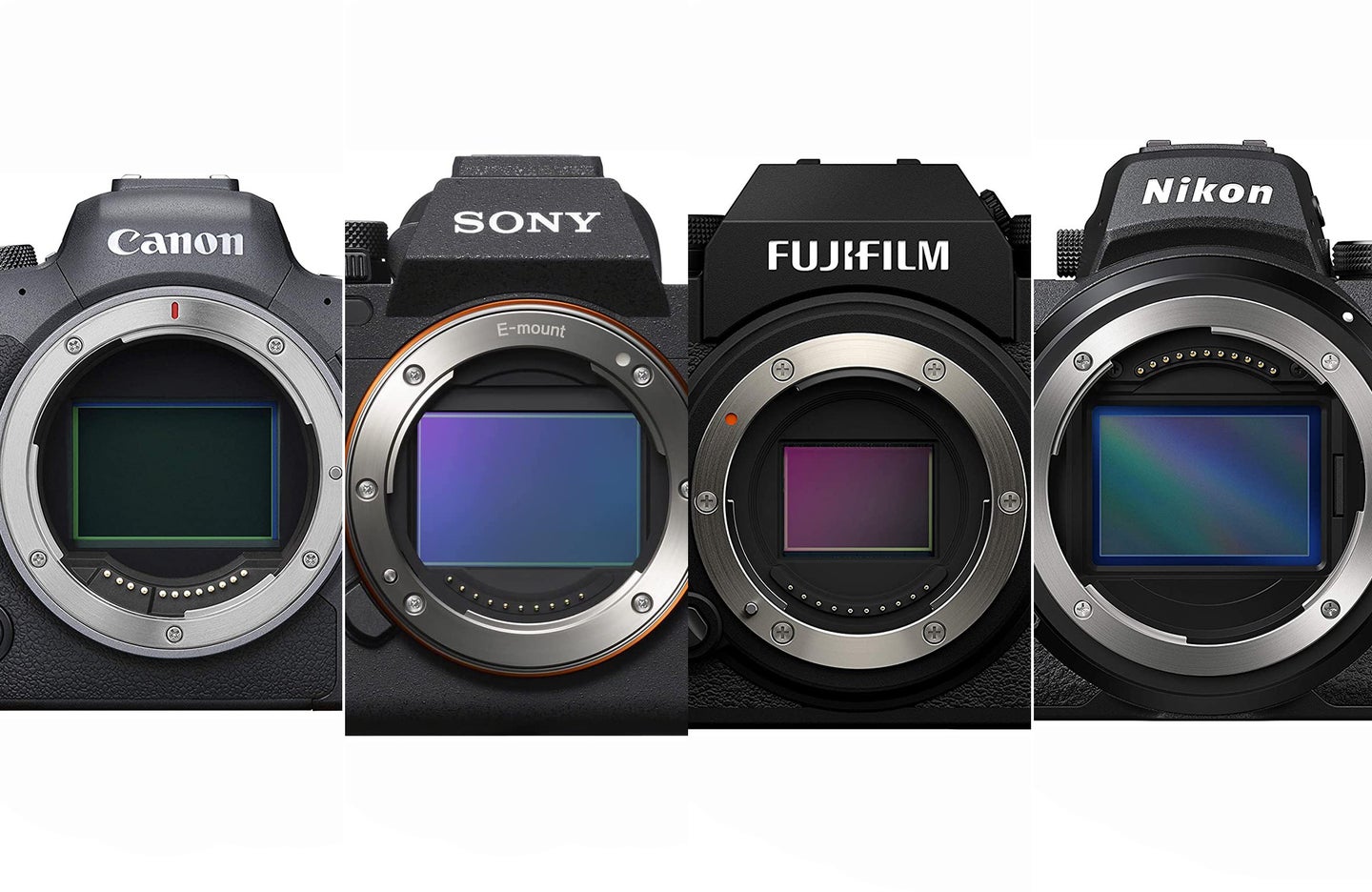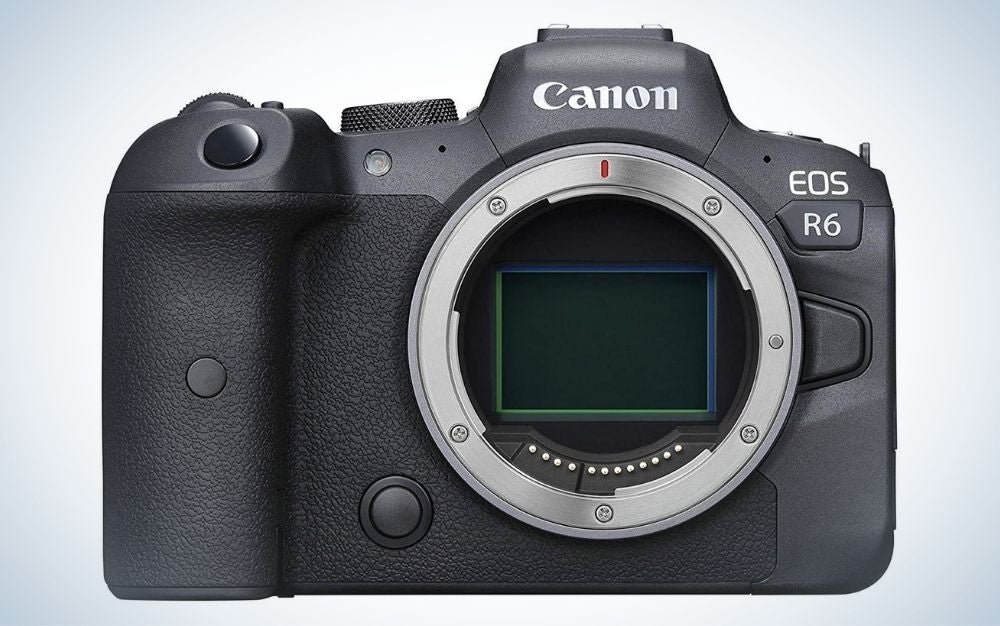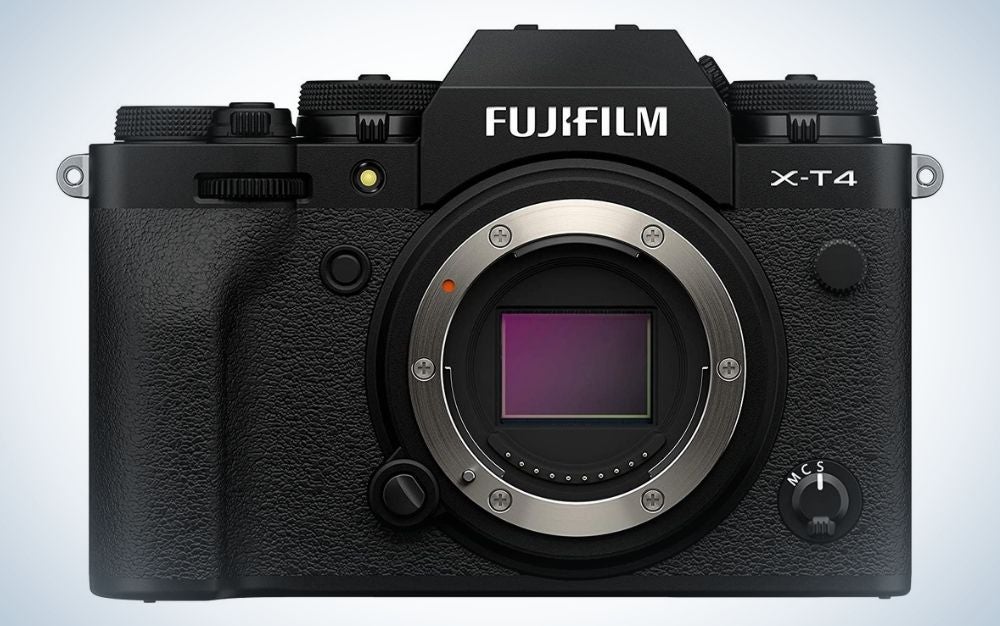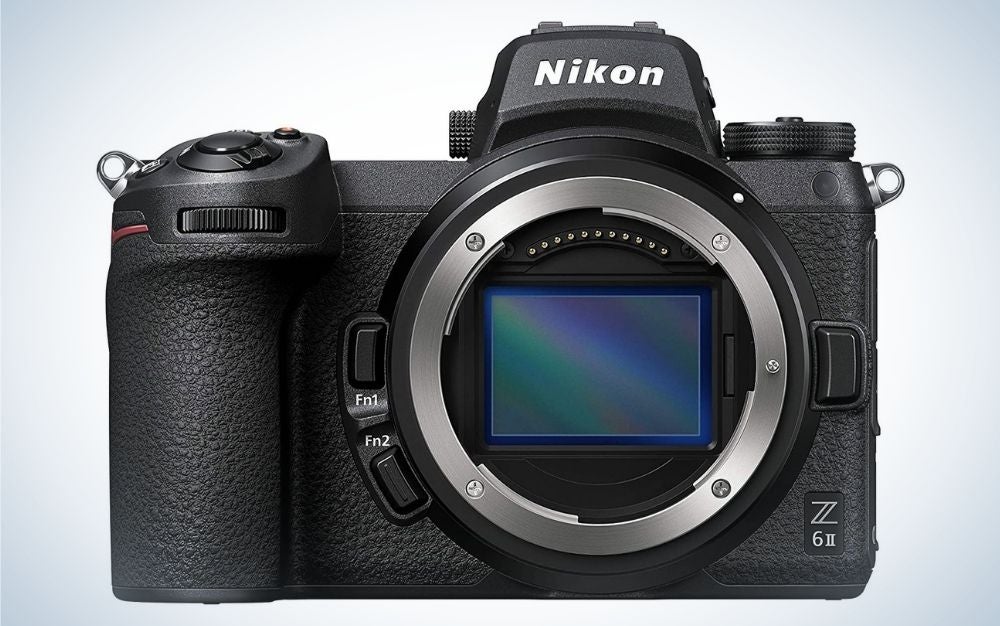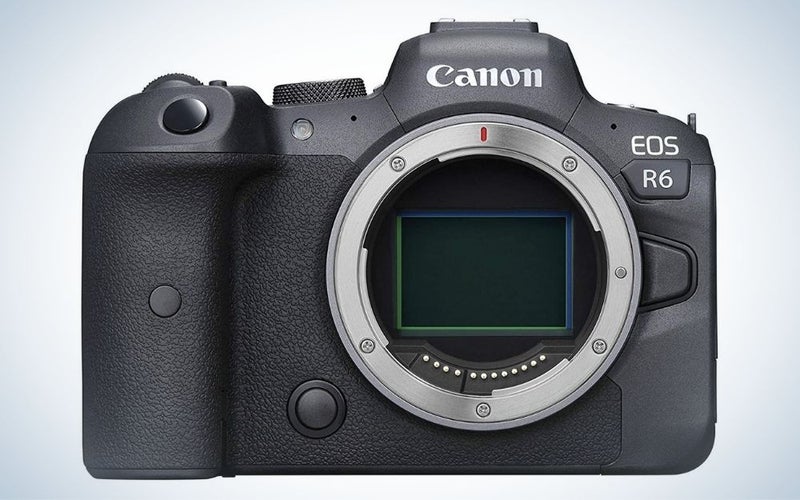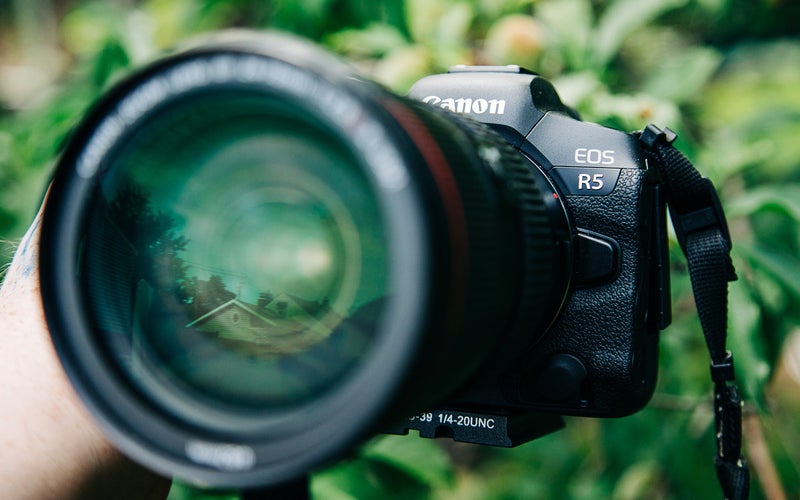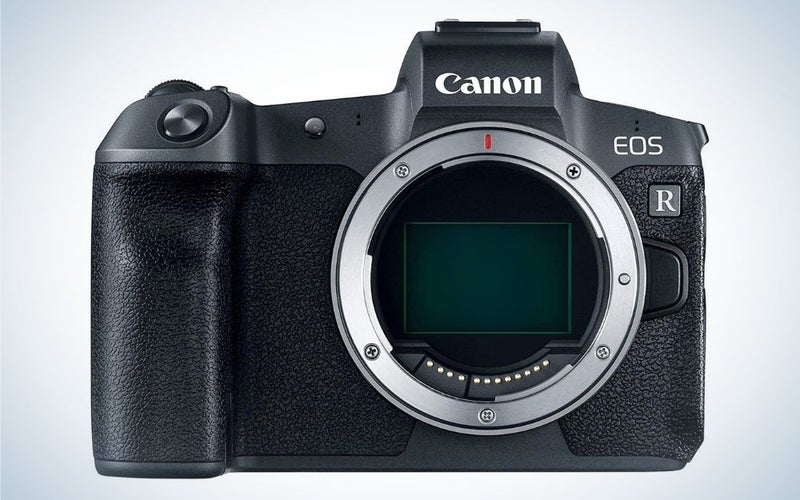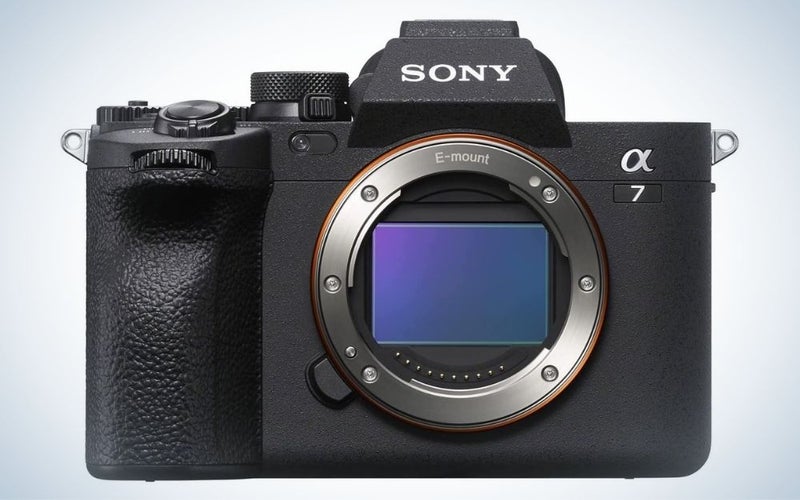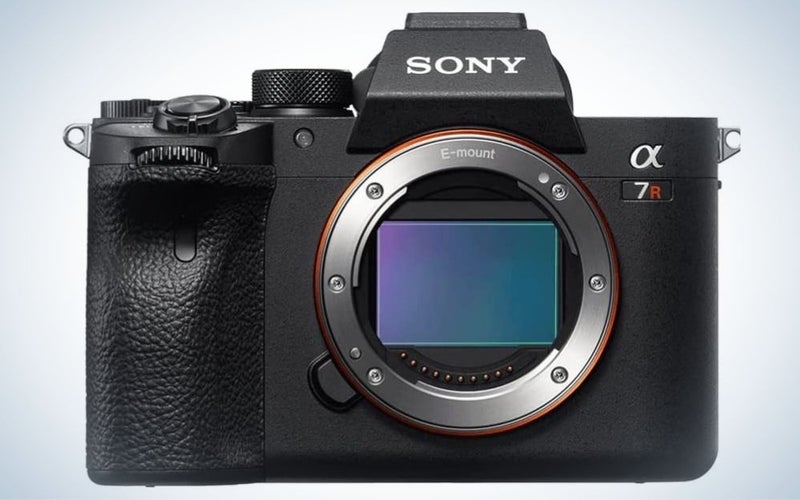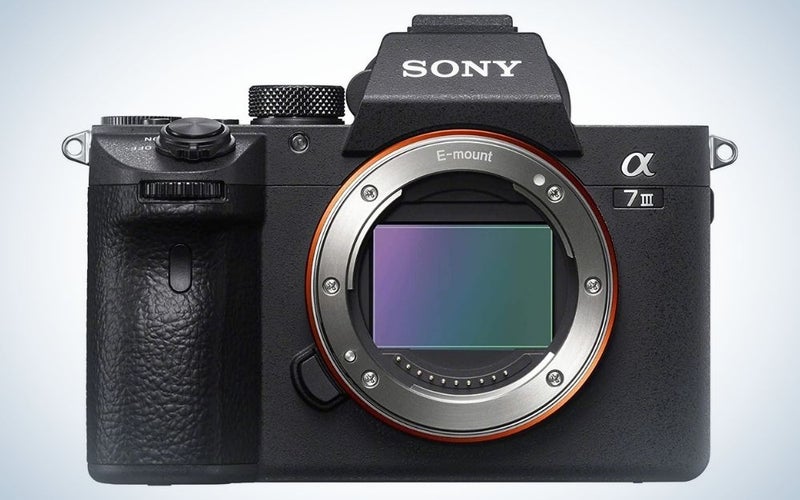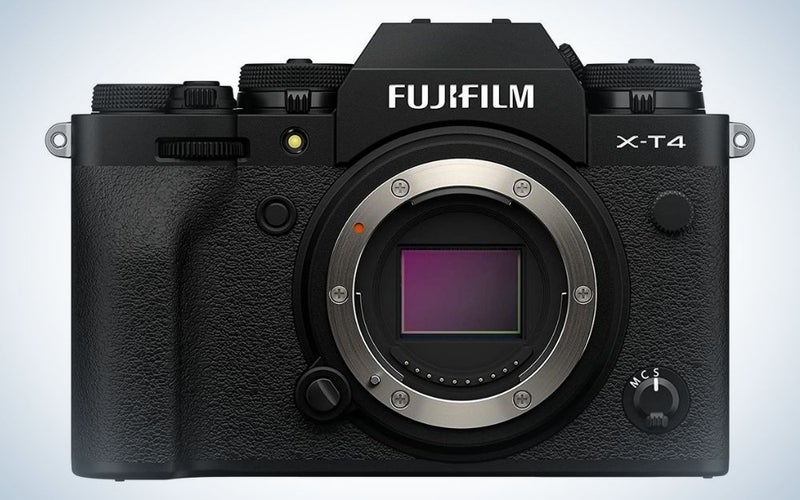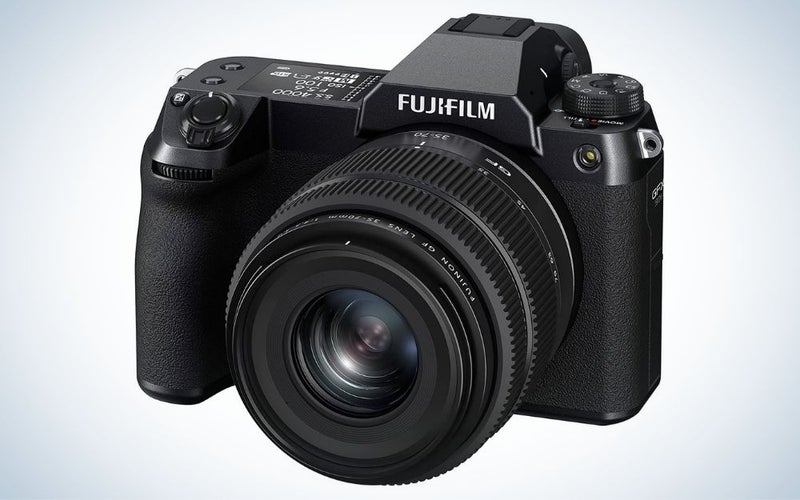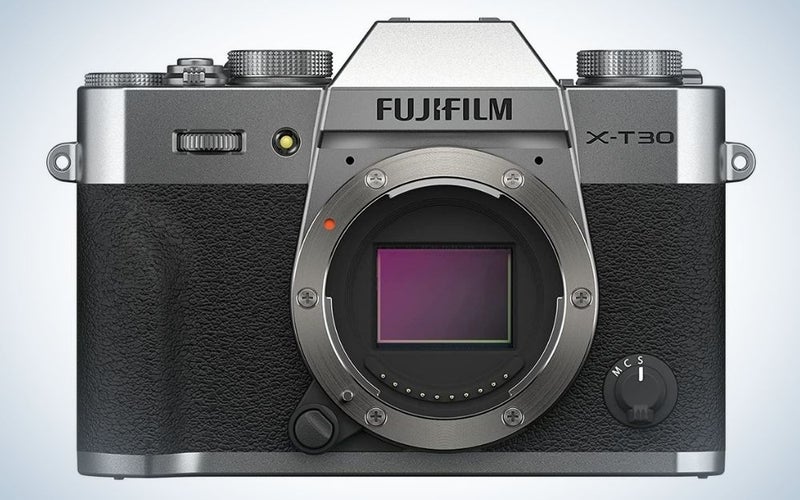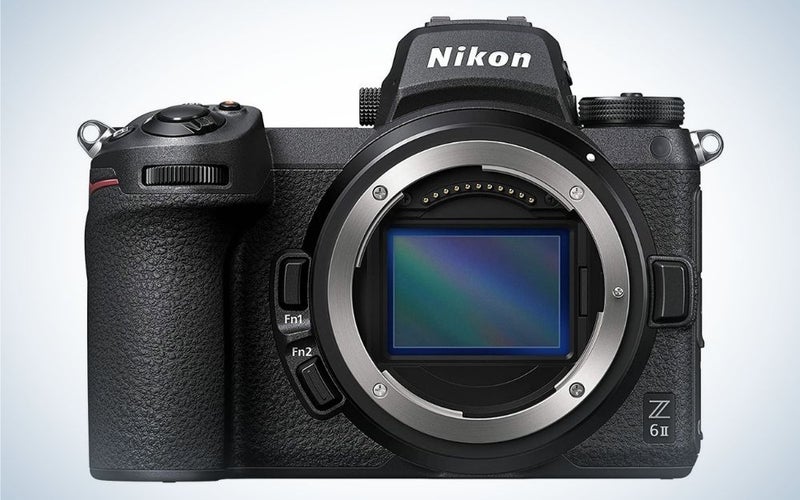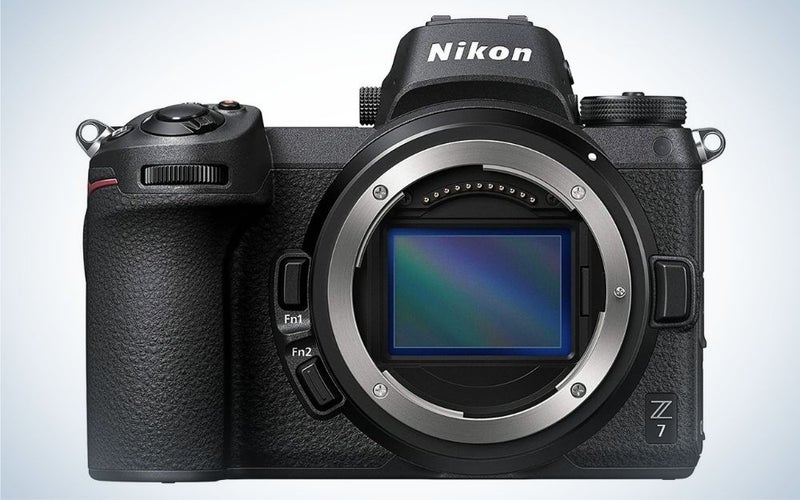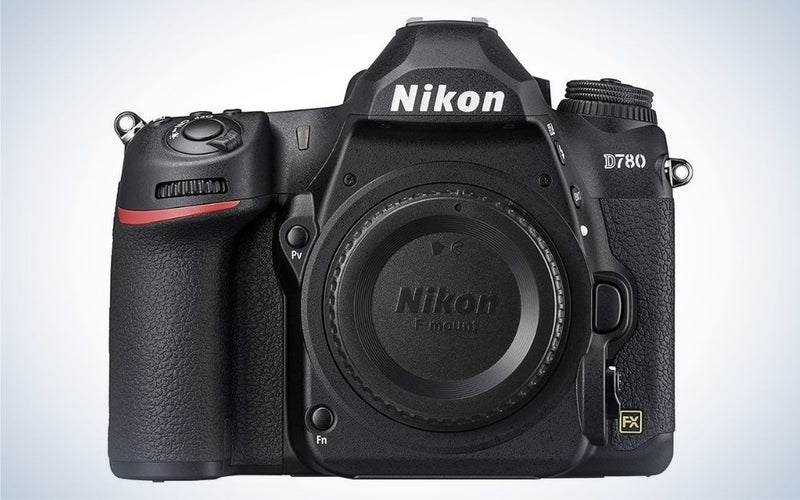We may earn revenue from the products available on this page and participate in affiliate programs. Learn more ›
Wedding photographers have unique needs when it comes to a camera. They need a body that will pump out immaculate image quality that can stand up to huge prints and nit-picking clients. At the same time, those cameras also need to be tough enough to endure brutally long weekends in which pretty much anything can happen. A rainy outdoor ceremony? Rowdy guests tearing up the dance floor? The best cameras for wedding photography can survive it all.
- Best overall (Canon): Canon EOS R6
- Best upgrade (Canon): Canon EOS R5
- Best budget (Canon): Canon EOS R
- Best overall (Sony): Sony A7 IV
- Best upgrade (Sony): Sony A7R IV
- Best budget (Sony): Sony A7 III
- Best overall (Fujifilm): Fujifilm X-T4
- Best upgrade (Fujifilm): Fujifilm GFX 50S II
- Best budget (Fujifilm): Fujifilm X-T30 II
- Best overall (Nikon): Nikon Z6 II
- Best upgrade (Nikon): Nikon Z7 II
- Best budget (Nikon): Nikon D780
How we picked the best cameras for wedding photography
As a long-time editor and contributor for PopPhoto, I have spent well over a decade reviewing cameras. I have also been shooting weddings for nearly 15 years, during which time I’ve had every possible malfunction, and weird situation try to throw a wrench in my work. To pick the best cameras for wedding photography, I surveyed the top models from the major manufacturers (many of which I have used first-hand) and selected those with professional-grade image quality and build. They check all the major necessary boxes and have earned a spot in a working photographer’s bag.
The best cameras for wedding photography: Reviews & recommendations
I have broken up our picks by manufacturer because picking a camera brand is a big commitment. I have also offered upgrades and budget picks to accommodate different budgets. None of the cameras on the list are cheap, but that’s because you’re buying professional equipment for work and not a hobby. You won’t regret the investment in the long run.
Best overall (Canon): Canon EOS R6
Canon
Why it made the cut: Canon’s mid-level mirrorless camera keeps file sizes reasonable while offering excellent image quality and solid autofocus.
Specs:
- Sensor size: Full-frame
- Lens mount: Canon RF
- Resolution: 20 megapixels
- Weight: 1.4 pounds
Pros:
- Excellent image quality
- Reliable autofocus
- Relatively compact
- Solid build quality
Cons:
- Not as many tactile controls as a pro might like
Canon’s mid-level mirrorless camera strikes a balance between performance and price. It offers essential features like two SD card slots for backing up images in real-time and a full-frame sensor that produces accurate, punchy images. Canon has some of the best color science around, so the files are easy to edit and work well with most popular presets.
The camera itself is relatively compact compared to other pro cameras, which you’ll appreciate after lugging it around all day. The 20-megapixel resolution may seem a little low, but when you’re shooting thousands of images over the course of a day, the manageable file size makes editing much simpler.
Best upgrade (Canon): Canon EOS R5
Stan Horaczek
Why it made the cut: Canon’s workhorse mirrorless camera offers more tactile controls and tons of resolution to work with.
Specs:
- Sensor size: Full-frame
- Lens mount: Canon RF
- Resolution: 45 megapixels
- Weight: 1.6 pounds
Pros:
- High-resolution sensor for tons of detail
- Absurd levels of autofocus control
- High-end video features
- Lots of tactile controls
Cons:
- Bigger than the R6
- Large raw files require lots of cards and computing power to edit
If you have the budget to step up in the Canon lineup, the R5 offers everything the R6 does, but amplified. The 45-megapixel sensor provides excellent low-light performance and tons of room to crop your images during editing. It’s bigger than the R6 but still smaller and lighter than the old pro DSLRs.
Canon’s R5 supports two memory cards, one of which is the ultra-rugged CF Express format. The body also has very robust weather-sealing, so you don’t need to flinch if you have to shoot a ceremony at the beach or in the rain. The files are big, so make sure you have the storage space and the computer power you need to edit thousands of them from every gig.
Best budget (Canon): Canon EOS R
Canon
Why it made the cut: With a large enough resolution to get quality images but not so large you need oodles of storage space, the EOS R is the ideal Canon budget pick.
Specs:
- Sensor size: Full-frame
- Lens mount: Canon RF
- Resolution: 30.3 megapixels
- Weight: 1.46 pounds
Pros:
- Excellent image quality
- 30 is the sweet spot for megapixels
- Solid autofocus
Cons:
- Only one card slot
Canon was relatively late to the Mirrorless market, but its first entries were very solid efforts. The EOS R offers an excellent 30.3-megapixel sensor that’s comparable to the one found in the 5D Mark IV DSLR. That’s a sweet spot in terms of resolution—it’s enough to capture lots of detail without bogging down cards or editing processes.
It has a solid selection of tactile controls, though the navigation on the back of the camera is a tangible downgrade from the higher-end models. One big caveat: The EOS R only has one memory card slot, which means you can’t create real-time backups of your images like you could with two slots. If your card fails mid-wedding, those images are gone unless you can recover them with pricey data recovery services. If you opt for this as your primary camera, be sure to have a lot of cards and switch them out frequently so if one of them fails, you don’t lose out on a ton of images.
Best overall (Sony): Sony A7 IV
Sony
Why it made the cut: Sony brought many features from its much pricier flagship camera into this pro-grade mirrorless camera.
Specs:
- Sensor size: Full frame
- Lens mount: Sony E
- Resolution: 33 megapixels
- Weight: 1.4 pounds
Pros:
- Sony’s advanced sensor provides excellent image quality
- Powerful image processors make quick work of photos
- Lots of tactile controls
- Robust weather-sealing
- Excellent viewfinder
Cons:
- Clunky menu system
Sony’s flagship A1 camera does just about everything you could ever want a camera to do, but it’s overkill for, well, just about everyone. The A7 IV borrows heavily from that flagship and offers some of the most powerful image processing hardware around. The 33-megapixel sensor offers an extensive dynamic range and excellent overall image quality at a resolution big enough for large prints but not so big that it’ll bog down your shooting and editing process.
Sony’s camera bodies are compact but comfortable, though its menu systems can be clunky, especially as you’re just getting used to them. Nevertheless, the A7 IV is one of the best wedding cameras you’ll find for the price.
Best upgrade (Sony): Sony A7R IV
Sony
Why it made the cut: With a whopping 61-megapixel sensor, the A7R IV is ideal for the wedding photographer making massive prints.
Specs:
- Sensor size: Full-frame
- Lens mount: Sony E
- Resolution: 61 megapixels
- Weight: 1.46 pounds
Pros:
- High-resolution 61-megapixel sensor
- Wide dynamic range
- Solid build
Cons:
- Just OK low-light shooting
More megapixels don’t always mean better photos, but they also don’t hurt. Sony’s high-resolution body offers a full 61-megapixels of resolution, which can come in handy if you’re trying to make large prints or aggressive crops. The body is built to be extremely rugged, so you don’t have to worry about abusing it, and the large viewfinder is solid for composing and reviewing images. Some wedding photographers shoot a camera like this for things like posed portraits and family shots but then switch to something more nimble and manageable for tougher situations like receptions and ceremonies.
Best budget (Sony): Sony A7 III
Sony
Why it made the cut: Despite being a generation old, the A7III still holds its own with an excellent sensor, good low-light performance, and fast bursts.
Specs:
- Sensor size: Full-frame
- Lens mount: Sony E
- Resolution: 24.3 megapixels
- Weight: 1.44 pounds
Pros:
- Excellent image quality
- Up to 10 fps which is a lot for a camera at this price
- Built-in image stabilization
Cons:
- Getting old
While it’s a generation old, Sony’s A7 III has the benefit of several generations of refinement. It has Sony’s well-worn 24.3-megapixel full-frame sensor, which is still competitive with current-generation cameras. The A7 III is relatively compact compared to higher-end models, and it still offers the necessary pro features like dual card slots.
While most of the budget options on this list make the most sense as a backup body, the A7 III could still be a main camera without a problem.
Best overall (Fujifilm): Fujifilm X-T4
Fujifilm
Why it made the cut: It’s rugged, compact, and relatively affordable.
Specs:
- Sensor size: APS-C
- Lens mount: Fujifilm X
- Resolution: 26.1 megapixels
- Weight: 1.34 pounds
Pros:
- Burly weatherproofing
- Compact
- 6.5 stops of image stabilization
- Rated for 300,000 actuations
Cons:
- Smaller sensor
- Relatively limited lens selection
Fujifilm has done more with APS-C sensors than any other company. The X-T4 has a very robust feature set, including a 26.1-megapixel sensor, 6.5 stops of built-in image stabilization, and weatherproofing on par with other manufacturers’ pro bodies.
Because the sensor is slightly smaller, the body is also more compact than its full-frame competition. It has two card slots, and the aperture control is on the camera’s lens, which I really like from a usability standpoint. While Fujifilm doesn’t have the legacy lens options Canon and Nikon offer, Fujifilm’s X-mount lenses are generally excellent with some real standouts like the 56mm f/1.2 and the 24mm f/1.4.
Best upgrade (Fujifilm): Fujifilm GFX 50S II
Fujifilm
Why it made the cut: A larger senor gives this camera high resolution and depth of field effects even full-frame cameras can’t match.
Specs:
- Sensor size: Medium format
- Lens mount: Fujifilm G mount
- Resolution: 50 megapixels
- Weight: 1.98 pounds
Pros:
- Larger sensor creates unique depth of field effects
- Excellent, accurate color reproduction
- Huge dynamic range
Cons:
- Big
- Heavy
Medium format digital cameras used to cost about as much as a family sedan, but Fujifilm’s GFX cameras have brought that price down considerably. The GFX 50S II offers many features you’d expect from a pro-full-frame mirrorless camera, including an in-body image stabilization system and advanced object tracking AF.
The larger sensor requires specific lenses, but it offers unique depth of field effects and a more three-dimensional look to the images. Just be sure to get in your forearm workouts before lugging it around all day because it’s big and heavy.
Best budget (Fujifilm): Fujifilm X-T30 II
Fujifilm
Why it made the cut: Fujifilm’s mid-level mirrorless camera borrows features from its high-end offerings.
Specs:
- Sensor size: APS-C
- Lens mount: Fujifilm X
- Resolution: 26.1 megapixels
- Weight: 13.5 ounces
Pros:
- Compact
- Rugged
- Same sensor as models above it
Cons:
- No built-in image stabilization
- Single memory card slot
If you can’t quite swing the price of an X-T4, the X-T30 II offers very similar hardware at a lower price. You get the same 26.1-megapixel resolution, 8 fps shooting, and an advanced autofocus system. It doesn’t have a huge viewfinder, but it does have a built-in flash, which could come in handy in a pinch. Like many other budget offerings on this list, it only has one memory card slot, which means no real-time backup of your files.
Best overall (Nikon): Nikon Z6 II
Nikon
Why it made the cut: Nikon’s mid-level full-frame mirrorless camera emphasizes the features wedding photographers really need.
Specs:
- Sensor size: Full-frame
- Lens mount: Nikon Z
- Resolution: 24.5 megapixels
- Size: 5.3 × 4.0 × 2.8″
- Weight: 1.55 pounds
Pros:
- Borrows features from the flagship Z7 II
- Hits a sweet spot for image resolution
- Impressive metering
- Advanced autofocus
- Two memory card slot
- Spectacular in low light
Cons:
- Comparatively limited tactile controls
Nikon’s mid-level full-frame mirrorless camera checks all the boxes a wedding photographer really needs. Its 24.5-megapixel resolution provides plenty of image data, even for big prints, but it leaves lots of room on the sensor for large pixels that shine in low-light situations. It handles like a small DSLR with a large, fast viewfinder and a decent selection of on-camera controls. Nikon’s first-party adapter gives it easy access to older-but-still-excellent Nikon glass in case you’re trying to make a gradual switch to mirrorless and want to keep using your DSLRs as backups or second bodies.
While it’s not the highest-end model Nikon offers, this is the sweet spot for most shooters. It does everything you need, but not much that you don’t. And it does all of it very well. It’s not built as burly as some of its higher-end siblings, but it feels very sturdy and can take the abuse that weddings dole out.
Best upgrade (Nikon): Nikon Z7 II
Nikon
Why it made the cut: The 45.7-megapixel sensor offers nearly twice as much resolution as the step-down model.
Specs:
- Sensor size: Full-frame
- Lens mount: Nikon Z
- Resolution: 45.7 megapixels
- Size: 5.3 x 4 x 2.7″
- Weight: 1.4 pounds
Pros:
- High-resolution sensor makes the most of Z lenses
- Advanced video features
- Robust weather-sealing
- Nikon’s excellent metering and AF systems
Cons:
- Good, but not incredible in low-light
Before Nikon’s monstrous Z9 came along, the Z7 II was the company’s flagship full-frame mirrorless camera. While the Z9 isn’t right for wedding shooting, the Z7 II offers a useful mixture of high-res capture with fast AF and Nikon’s renowned metering systems.
Despite its large image files, the Z7 II can still shoot at up to 10 fps in full-res raw, which is more than any wedding photographer will ever need. The body boasts excellent weather-sealing and a burly body that can withstand the rigors of a long wedding season. Despite all these smarts, the Z7 II is still smaller and lighter than a typical Nikon DSLR, which your back, hands, and forearms will truly appreciate as you go into hour nine of a wedding shoot.
Best budget (Nikon): Nikon D780
Nikon
Why it made the cut: Even in a mostly mirrorless world, the D780 still has everything a wedding shooter would need for long shoots.
Specs:
- Sensor size: Full-frame
- Lens mount: Nikon F
- Resolution: 24.5 megapixels
- Size: 5.7 x 4.6 x 3″
- Weight: 1.9 pounds
Pros:
- Excellent low-light performance
- Very durable
- Super-fast AF
- Lag-free optical viewfinder
Cons:
- Nikon slowing down DSLR lens production
Even though it’s years old by now, the Nikon D780 could still easily work as a primary camera for serious wedding photography. It has two memory card slots, a 24.5-megapixel sensor that’s excellent in low-light, and a very sturdy build that won’t break during work. You get Nikon’s excellent color reproduction and metering system, too. Some shooters still prefer DSLRs to mirrorless cameras in some instances, including wedding dance floors where dark conditions can make electronic viewfinders seem laggy and smeary.
The body offers lots of tactile feedback, and even though it’s heavier than its mirrorless counterparts, it’s not as big and heavy as other high-end Nikon DSLRs. It’s a true workhorse of a camera that will serve you well for years.
Features to consider
Whether you’re just starting or a hardened professional, choosing gear can greatly impact your wedding season and business in general. Here are some essential things to consider before you take the leap on a new camera.
Camera system
Cameras can’t exist on their own; you need lenses to go with them. What kind of lenses you pick depends on what body you choose. When considering a system, peruse the company’s current lens offerings to see what’s currently available to match your shooting style. It’s worthwhile to check the secondary and refurbished markets, too. In that regard, Canon and Nikon have a big advantage over the competition because there are a ton of older DSLR lenses out there that still have lots of life left in them, thanks to first-party adapters.
If you’re currently using a specific camera system, make sure you have a hard and fast reason for leaving and going to another company’s gear. Switching all your gear can typically result in a loss since you have to start from scratch, and you may not get top dollar for your older stuff on the secondary market.
Full-frame vs. APS-C
Peruse the list above, and you’ll notice that all but the Fujifilm options offer full-frame sensors rather than APS-C chips. While full-frame isn’t absolutely essential for shooting weddings, it typically provides advantages for depth of field effects and low-light shooting. Professional-grade cameras also tend to employ full-frame sensors along with their other pro features. Fujifilm has done wonders with its APS-C models, so choose the camera you like instead of getting hung up on sensor size.
Ruggedness and weatherproofing
You may not think it to look at serene wedding photos, but a full day of wedding shooting is a punishing camera crucible. Even if you have a backup, breaking a camera during a wedding feels horrible and might lead to you missing shots, so it’s worth paying extra for tougher cameras. Many of the cameras on this list rely on magnesium alloy chassis instead of plastic to make them rugged. They also promise high-end weather-sealing to keep out dust and rain. Pro cameras are built to be robust, and that’s extremely valuable for wedding shooters.
Mirrorless vs. DSLRs
Modern mirrorless cameras have some very tangible advantages over DSLRs at this point in the game. For example, autofocus tracking has gotten impossibly good with mirrorless. And buying a mirrorless camera allows you to use legacy DSLR lenses as well as new mirrorless lenses as they come out. There are a few budget DSLR options on this list, but mirrorless is the way of the future, and that’s probably where you should be if you’re investing in a photography business.
FAQs
Q: What camera equipment do I need to shoot a wedding?
This could be an entire lengthy article all on its own, but here’s the minimum kit you’ll need to get out there and shoot weddings for real.
– Two camera bodies (even if you only shoot with one, a backup is a must)
– Durable lenses at different focal lengths that can take a whack or drop and not fall apart
– Lots of extra batteries
– An external flash for dark locations
– Flash batteries
– Lots of memory cards
– A lens cloth
Q: Is a 50mm lens good for weddings?
Details are important when it comes to answering this question. 50mm can be a beneficial focal length at a wedding for loose portraits, details, and getting ready shots. Many photographers, however, fall into the trap of using a cheap, plastic 50mm lens for weddings. While those lenses offer image quality that’s up to snuff for pro shooting, they’re very fragile. Bang one against a church pew, and it’s toast. The same goes for taking it out into the elements. If you’re going to rely heavily on a 50mm lens, get an upgraded version.
Q: Which lens is best for wedding photography?
A typical wedding kit includes a standard zoom like the classic 24-70mm f/2.8. That lens can handle almost anything you can throw at it, from getting ready shots to formal portraits. I personally add a 70-200mm f/2.8 and a 35mm f/1.4 prime to my kit, which keeps me covered for pretty much anything.
A final word on the best cameras for wedding photography
If you’re going to get into wedding photography, you’ll need pro gear, so think of this as an investment. You want a camera that will offer great image quality, but you also need something durable enough to endure the work. Also, make sure you have at least one backup body in case your primary camera breaks. You don’t want to end up having to shoot the rest of the day on your iPhone.
